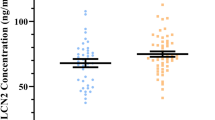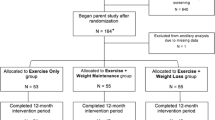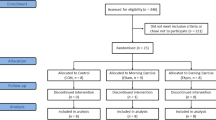Abstract
Background:
Elevated circulating levels of soluble lectin-like oxidized low-density lipoprotein receptor-1 (sLOX-1) have been observed in obese persons and are reduced by weight loss. However, it is not known whether combining caloric restriction (CR) with exercise training is better in reducing sLOX-1 levels than CR alone.
Objective:
We examined whether the addition of aerobic exercise to a weight loss intervention differentially affects sLOX-1 levels in 61 abdominally obese post-menopausal women randomly assigned to a CR only (n=22), CR+moderate-intensity exercise (n=22) or CR+vigorous-intensity exercise (n=17) intervention for 20 weeks. The caloric deficit was ∼2800 kcal per week for all groups.
Results:
The intervention groups were similar at baseline with respect to body weight, body composition, lipids and blood pressure. However, plasma sLOX-1 levels were higher in the CR-only group (99.90±8.23 pg ml−1) compared with both the CR+moderate-intensity exercise (69.39±8.23 pg ml−1, P=0.01) and the CR+vigorous-intensity exercise (72.83±9.36 pg ml−1, P=0.03) groups. All three interventions significantly reduced body weight (∼14%), body fat and waist and hip circumferences to a similar degree. These changes were accompanied by a 23% reduction in sLOX-1 levels overall (−19.00±30.08 pg ml−1, P<0.0001), which did not differ among intervention groups (P=0.13). Changes in body weight, body fat and maximal oxygen consumption (VO2 max) were not correlated with changes in sLOX-1 levels. In multiple regression analyses in all women combined, baseline sLOX-1 levels (β=−0.70±0.06, P<0.0001), age (β=0.92±0.43, P=0.03) and baseline body mass index (BMI) (β=1.88±0.66, P=0.006) were independent predictors of the change in sLOX-1 with weight loss.
Conclusions:
Weight loss interventions of equal energy deficit have similar effects on sLOX-1 levels in overweight and obese post-menopausal women, with the addition of aerobic exercise having no added benefit when performed in conjunction with CR.
This is a preview of subscription content, access via your institution
Access options
Subscribe to this journal
Receive 12 print issues and online access
$259.00 per year
only $21.58 per issue
Buy this article
- Purchase on Springer Link
- Instant access to full article PDF
Prices may be subject to local taxes which are calculated during checkout



Similar content being viewed by others
References
Chui PC, Guan HP, Lehrke M, Lazar MA . PPARgamma regulates adipocyte cholesterol metabolism via oxidized LDL receptor 1. J Clin Invest 2005; 115: 2244–2256.
Mehta JL, Chen J, Hermonat PL, Romeo F, Novelli G . Lectin-like, oxidized low-density lipoprotein receptor-1 (LOX-1): a critical player in the development of atherosclerosis and related disorders. Cardiovasc Res 2006; 69: 36–45.
Nagase M, Ando K, Nagase T, Kaname S, Sawamura T, Fujita T . Redox-sensitive regulation of lox-1 gene expression in vascular endothelium. Biochem Biophys Res Commun 2001; 281: 720–725.
Murase T, Kume N, Kataoka H, Minami M, Sawamura T, Masaki T et al. Identification of soluble forms of lectin-like oxidized LDL receptor-1. Arterioscler Thromb Vasc Biol 2000; 20: 715–720.
Hayashida K, Kume N, Murase T, Minami M, Nakagawa D, Inada T et al. Serum soluble lectin-like oxidized low-density lipoprotein receptor-1 levels are elevated in acute coronary syndrome: a novel marker for early diagnosis. Circulation 2005; 112: 812–818.
Kamezaki F, Yamashita K, Tasaki H, Kume N, Mitsuoka H, Kita T et al. Serum soluble lectin-like oxidized low-density lipoprotein receptor-1 correlates with oxidative stress markers in stable coronary artery disease. Int J Cardiol 2008; 134: 285–287.
Tan KC, Shiu SW, Wong Y, Leng L, Bucala R . Soluble lectin-like oxidized low density lipoprotein receptor-1 in type 2 diabetes mellitus. J Lipid Res 2008; 49: 1438–1444.
Brinkley TE, Kume N, Mitsuoka H, Phares DA, Hagberg JM . Elevated soluble lectin-like oxidized LDL receptor-1 (sLOX-1) levels in obese postmenopausal women. Obesity (Silver Spring) 2008; 16: 1454–1456.
Nomata Y, Kume N, Sasai H, Katayama Y, Nakata Y, Okura T et al. Weight reduction can decrease circulating soluble lectin-like oxidized low-density lipoprotein receptor-1 levels in overweight middle-aged men. Metabolism 2009; 58: 1209–1214.
Nicklas BJ, Wang X, You T, Lyles MF, Demons J, Easter L et al. Effect of exercise intensity on abdominal fat loss during calorie restriction in overweight and obese postmenopausal women: a randomized, controlled trial. Am J Clin Nutr 2009; 89: 1043–1052.
American College of Sports Medicine. ACSM's Guidelines for Exercise Testing and Prescription, 6th edn. Lippincott Williams & Wilkins: Baltimore, 2000.
Kume N, Kita T . Roles of lectin-like oxidized LDL receptor-1 and its soluble forms in atherogenesis. Curr Opin Lipidol 2001; 12: 419–423.
Lubrano V, Del Turco S, Nicolini G, Di Cecco P, Basta G . Circulating levels of lectin-like oxidized low-density lipoprotein receptor-1 are associated with inflammatory markers. Lipids 2008; 43: 945–950.
Shiu SW, Tan KC, Wong Y, Leng L, Bucala R . Glycoxidized LDL increases lectin-like oxidized low density lipoprotein receptor-1 in diabetes mellitus. Atherosclerosis 2008; 203: 522–527.
Mitsuoka H, Kume N, Hayashida K, Inui-Hayashiada A, Aramaki Y, Toyohara M et al. Interleukin 18 stimulates release of soluble lectin-like oxidized LDL receptor-1 (sLOX-1). Atherosclerosis 2008; 202: 176–182.
Acknowledgements
We are grateful to the study coordinators, dietitians, exercise physiologists, nurses and other research staff of the Wake Forest University General Clinical Research Center and Geriatric Research Center for their assistance in the conduct of this study. We would also like to thank all the women who volunteered to participate in this study. This study was supported by NIH grants R01-AG/DK20583, the Wake Forest University Claude D Pepper Older Americans Independence Center (P30-AG21332) and the Wake Forest University General Clinical Research Center (M01-RR07122).
Author information
Authors and Affiliations
Corresponding author
Ethics declarations
Competing interests
The authors declare no conflict of interest.
Rights and permissions
About this article
Cite this article
Brinkley, T., Wang, X., Kume, N. et al. Caloric restriction, aerobic exercise training and soluble lectin-like oxidized LDL receptor-1 levels in overweight and obese post-menopausal women. Int J Obes 35, 793–799 (2011). https://doi.org/10.1038/ijo.2010.199
Received:
Revised:
Accepted:
Published:
Issue Date:
DOI: https://doi.org/10.1038/ijo.2010.199
Keywords
This article is cited by
-
Effects of exercise intensity on VO2max in studies comparing two or more exercise intensities: a meta-analysis
Sport Sciences for Health (2017)



